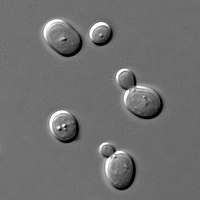
Photo from wikipedia
A novel, yeast-like fungal strain, Aureobasidium melanogenum TN3-1, that was isolated from natural honey can actively transform 140.0 g/L of glucose into 110.29 ± 2.17 g/L of pullulan during fermentation, whereas A. melanogenum P16… Click to show full abstract
A novel, yeast-like fungal strain, Aureobasidium melanogenum TN3-1, that was isolated from natural honey can actively transform 140.0 g/L of glucose into 110.29 ± 2.17 g/L of pullulan during fermentation, whereas A. melanogenum P16 and TN1-2 converted 140.0 g/L of glucose into only 45.81 ± 1.7 g/L and 48.7 ± 2.6 g/L of pullulan, respectively. It was noted that most of the cells in the culture of the strain TN3-1 were arthroconidia, while all of the yeast-like fungal cells of A. melanogenum P16 cultivated under the same conditions were blastoconidia. The cell sizes, cell walls and the number of small vacuoles of A. melanogenum TN3-1 were also much larger, thicker and higher, respectively, than those of A. melanogenum P16. The glycerol, trehalose and glycogen content in the A. melanogenum TN3-1 cells was higher than that of the A. melanogenum P16 and TN1-2 cells.
Journal Title: Food chemistry
Year Published: 2019
Link to full text (if available)
Share on Social Media: Sign Up to like & get
recommendations!